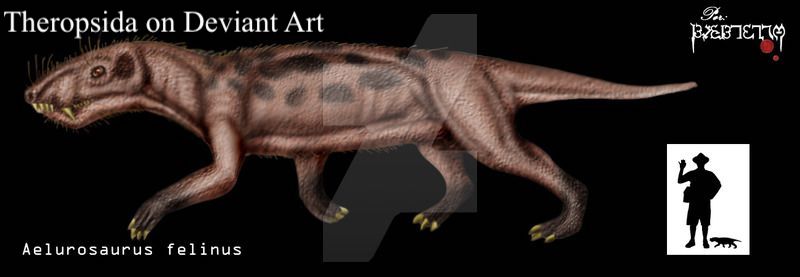Welcome to Aelurosaurus

Name Definition
Cat lizard
Name Given By
A. felinus/Richard Owen in 1881; A. whaitsi/Robert Broom in 1911; A. polyodon by Broom in 1935 (originally known as Galerhinus polyodon); A. wilmanae/Broom in 1940 (originally known as Aelurosauroides wilmanae); A.? watermeyeri/ Broom in 1940
Location
Karoo Basin of South Africa
Classification
Therapsida, Neotherapsida, Theriodontia, Gorgonopsidae
Size
around 70 cm long
Temporal Range
Roadian - Changhsingian stages of the Permian, around 272 - 251 million years ago
Ecological niche
small predator
Species/Sub Species
A. felinus (type species), A. whaitsi, A. polyodon, A. wilmanae, A.? watermeyeri (species placement in this genus is still controversial)
Diet
evidence suggests Aelurosaurus was most likely a carnivore of smaller reptiles and therapsids since its skull was ventrally tilted like other gorgonopsids which is a common feature of predators
Introduction
Aelurosaurus is a genus of extinct gorgonopsid therapsids that lived in South Africa during the Mid-Late Permian. Aelurosaurus was so named as “cat lizard” due to the fact that it appeared to be an ancestor of marsupials that were convergent (evolved similarly like) with cats, though it was not a true mammal itself yet. The type species, A. felinus, goes further into this cat-marsupial convergence ancestry since felinus has a close affinity with felines. The other species are A. whaitsi, who has a more stout snout than A. felinus which could be a juvenile feature of the genus. A. polyodon, the next species, has only a crushed snout, though due to the species name which means “multiple teeth”, it might mean that A. polyodon might have had more teeth than the other species. A. wilmanae’s differentiating feature is the overall larger snout compared to A. felinus, but it was only around 11 cm long. The skull of A. wilmanae is also by far the best preserved of all the species. Now, the last one is somewhat controversial, as A. watermeyeri shares features with both genera Aelurosaurus (features like a relatively large orbit and a short snout are present in Aelurosaurus), as well as the gorgonopsid Aloposaurus (a larger preparietal and postfrontal). Because most of Africa’s gorgonopsids have been found in the Karoo Basin, Aelurosaurus (while itself is a predator) would want to avoid direct competition with larger gorgonopsids to stay safe.
